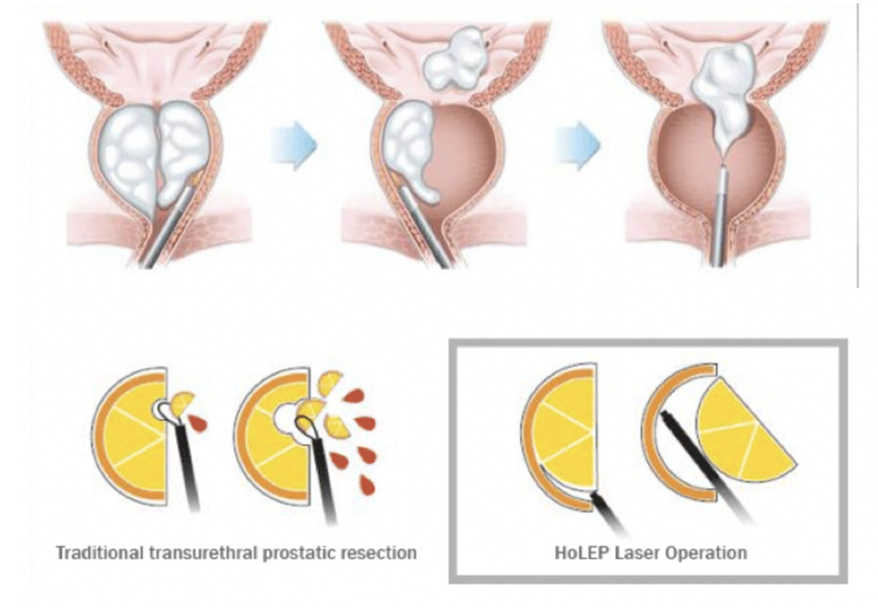HOLEP SURGERY
HoLEP , As Endoscopic Solution for Prostate Enlargement
Holmium Laser Enucleation of the Prostate : HoLEP
An enlarged prostate gland can cause uncomfortable urinary symptoms, such as blocking the uriner flow out of the bladder.
There are several effective treatments for prostate gland enlargement, including medical treatments as the first line therapy, endoscopic surgeries. To choose the best option, you and your doctor will consider your symptoms, prostate volume, shape of the prostate and other health conditions you might have and your preferences.
HoLEP is a modern alternative to standard Transurethral Resection of the Prostate (TURP) procedure for bladder outlet obstruction because of prostate enlargement (BPH). HoLEP endoscopic procedure requires a short hospital staying and anesthetic. Urethral catheter is also needed for 1 or 2 days, mostly. For early postoperative period, patients are advised to take his life quietly and to avoid straining or heavy lifting for about one month.

Who is suitable for HoLEP?
Holep can ben performed on men of any age with bladder outflow obstruction due to BPH. It is particularly indicated in men with large prostates over 80 grams in volume and men on medications to the blood such as clopidogrel, warfarin or aspirin. We can perform HoLEP in cases who have prostates larger than 200-300 grams.
What are the advantages of HoLEP?
There is no upper size limit of prostate volume; traditionally men with prostates over 100 grams in size needed major open surgery with longer hospital stay, more bleeding, longer urethral catheter time and complication risk.
There is often lees bleeding than after a TURP
Discharge is often quicker because of shorter hospital stay than TURP at 1 or 2 days.
The chance of recurrence requiring further surgery is very very low.
Unlike KTP laser (greenlight laser) operations, large quantities of prostate tissue are sent for pathological analysis.
The PSA mostly drops to very low levels after HoLEP
What are the disadvantages of HoLEP?
The procedure takes slightly longer than TURP but with no risk TUR syndrome.
HoLEP requires special training
The cost of the equipments are expensive resulting in slight higher cost than TURP
How does HoLEP work?
The aim of HoLEP is to relieve pressure on the tube (means urethra) through which the urine drains by anatomically enucleating the majority of excess benign prostate tissue. This is mostly done under general anesthesia using a telescopic camera inserted through the urethra. The three lobes of the prostate that are cıred out intact are pushed into the bladder before aspiration and morcellation by a special instrument inserted through the telescopic camera. The small pieces of the prostate are sent for pathology laboratory analysis just in case they might be found to be cancerous.
A Foley catheter is placed into the bladder to drain the urine while the raw surface heal, then left in place for around only 24 hours before being removed on the day of discharge from hospital. During his catheterization period, sterile saline fluid might be also irrigated into the bladder through the catheter to dilute and blood in the urine and prevent clot formation. It is normal to have some blood in the urine after HoLEP, so it is advisable to drink plenty of water for a few days while it clears. Clots are sometimes passed 10-15 days afterwards; again, this is part of the healing process.
The risk of infection that accompanies any endoscopic operation, the only significant side-effect is the near certainty that normal ejaculation will cease. This is because the contraction that occurs during orgasm may no completely block the entrance to the bladder once some tissue has been removed and the semen will flow back int the bladder (retrograde ejaculation) rather than out through the penis. This is not harmful, but is does mean that future spontaneous (not assisted reproduction) fertility is greatly reduced.
The HoLEP procedure does not affect erectile function or continence, although the urinary symptoms may take a few weeks to settle down afterwards.
You can follow Prof. Dr. Tibet Erdogru HoLEP experience with clicking the video.
Where is HoLEP performed ( by Dr. Tibet Erdogru ) ?
Prof. Dr. Tibet Erdogru consults his patients at UroKlinik Istanbul and undertakes the procedure at Acıbadem Taksim Hospital or Amerikan Hospital.
How much does HoLEP procedure cost?
If you are paying for your treatment yourself, the cost of HoLEP procedure will be in the region of 5.000 – 6.000 EURO for prostate volume lower than 200 grams. The cost of the procedure will be in the region of 7.000 – 8.000 EURO for prostate volume larger than 200-250 grams.
If you have private health insurance including Allianz Inc.
You can expect HoLEP operation to be covered.
How can you make an appointment?
Prof. Dr. Tibet Erdogru is available on Monday, Tuesday, Wednesday, Thursday afternoons at UroKlinik, Istanbul. Please send us e-mail or call us for an appointment on +90 549 804 0308 or send an e-mail to dr@tibeterdogru.com

Treatment of prostate, bladder, kidney and testicular cancers with robotic and laparoscopic surgery in urology

